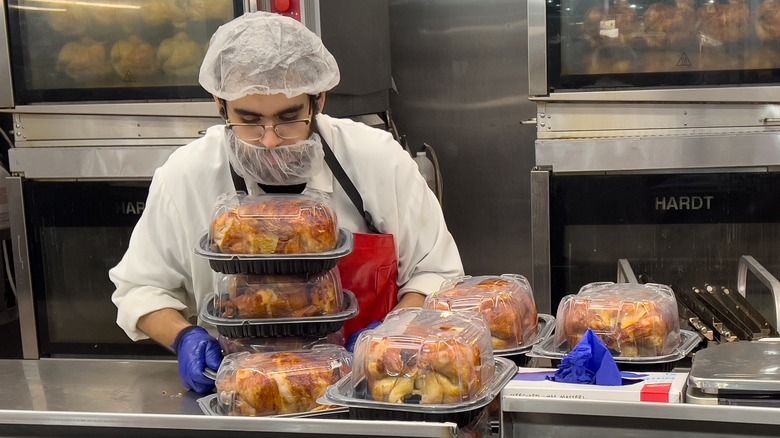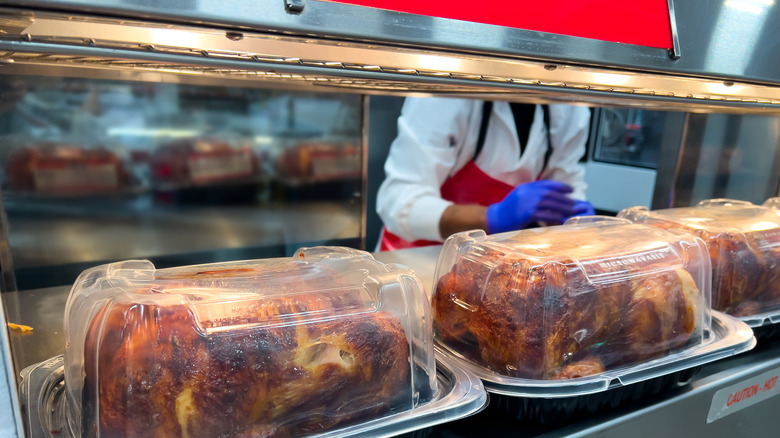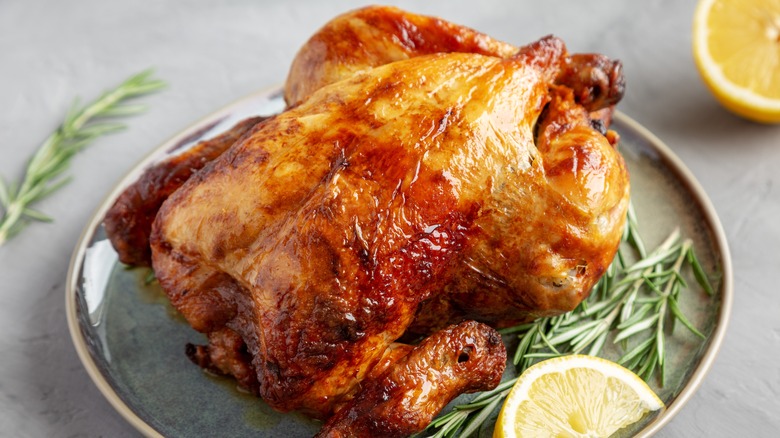The Food Safety Mistake You Never Want To Make With A Store-Bought Rotisserie Chicken
Swinging by the store after a long day to pick up a crisp rotisserie chicken makes dinner a no-brainer. Rotisserie chicken is also a pretty healthy choice, with one chicken breast (skin not eaten) containing 33.6 grams of protein, 341 milligrams of potassium, and 295 milligrams of phosphorus, among other essential vitamins and nutrients, according to the U.S. Department of Agriculture (USDA).
Admittedly, we sometimes wish we had a pair of oven mitts on hand when grabbing a chicken from underneath those heat lamps. However, while it may be easier on your fingertips, opting for a rotisserie chicken that's not as hot to the touch could potentially increase the risk of foodborne illness. Food safety consultant Jeff Nelken told Fox 11 Los Angeles that you don't want to make the mistake of choosing a cooler rotisserie chicken over a hotter one. "When you are touching it, it should be very warm to the touch, and it should be fully making contact with a heating environment so you know that it has been properly connecting to the surface," he stated. But just how hot is hot enough?
How hot rotisserie chicken should be to remain safe
Poultry that is safe for consumption should be heated to 165 degrees Fahrenheit or higher, as outlined by the U.S. Department of Agriculture (USDA). The agency describes the food temperature range between 40 degrees and 140 degrees Fahrenheit as the "Danger Zone." This is the range in which bacterial growth is at its fastest, with the microbial count climbing twice as high in just 20 minutes. Should the temperature of a rotisserie chicken fall below 140 degrees, Fox 11 Los Angeles reports that the cooked bird could pose potential health risks after four hours. This includes gastrointestinal discomfort, vomiting, diarrhea, fever, and headache, all of which are symptoms of food poisoning. More serious complications can potentially arise for young children, older adults, pregnant people, and those with compromised immunity.
In addition to the touch test to ensure that rotisserie chicken is being kept at a safe temperature, consumers can shop confidently by taking note of the labeled sticker many grocery stores place on their rotisserie chickens that indicates how long the chicken has been sitting out — a practice that has earned Costco high praise. Shoppers will be happy to know that the retailer doesn't let their famed birds sit out for more than two hours, per Business Insider. This is not due to a risk of spoilage, but rather to preserve optimal taste. Costco devotees David and Susan Schwartz, who jointly authored "The Joy of Costco: A Treasure Hunt from A to Z," told the publication that after two hours, Costco takes unsold rotisserie chickens and makes them into soup and salad ingredients.
More tips for safe consumption of rotisserie chicken
Nelken left Fox 11 Los Angeles with a few additional pointers to help cut down the amount of time your rotisserie chicken is exposed to room temperatures. This includes grabbing a chicken on the way out of the store rather than on your way in, and not making any stops on the way home. "You don't want [to be] driving around for two hours with the chicken in your car not having adequate temperature maintenance," he told the media outlet, emphasizing how doing so increases the risk of bacterial growth, such as E. coli or Salmonella.
Experts from the USDA's Meat and Poultry Hotline state that, upon arriving home, chicken should not be left out on the counter for more than two hours. On days when temperatures are upwards of 90 degrees, stick your chicken in the fridge within one hour. Just be sure to first strip away the meat from a hot rotisserie chicken before placing it in a fridge set to 40 degrees Fahrenheit to help it cool down faster. Once it's stored, here's how long chicken lasts as a leftover.


